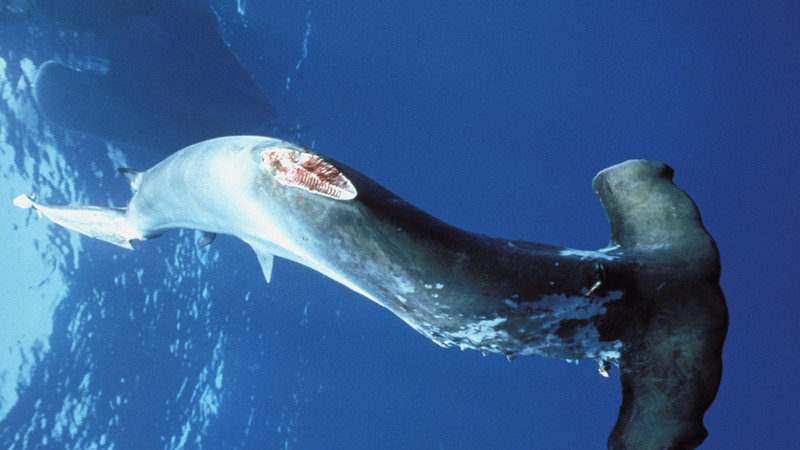What is Shark Finning?
Shark finning is the practice of removing the fins from a captured shark, and discarding the animal at sea, dead or even still living. This is a cruel practice that leaves the shark to drown or bleed to death. Previously, sharks captured as a non-targeted animal (bycatch) in the tuna and swordfish industry were released, but the high value and increased market for shark fins creates a huge incentive for fishermen to kill the shark and take only the fins. Typically the shark meat is low value and once the body is discarded, leaves room in the ship’s hold for the more valuable meat of the tuna or swordfish. The fins are small, easily concealed and have high value. Shark finning is wasteful, inhumane and unsustainable.

The practice of shark finning has been condemned by the United Nations and is illegal in most nations that recognize the unsustainable nature of this method of fishing. Considered a form of IUU fishing (Illegal, Unenforced and Unregulated), enforcement of shark fin at sea is extremely difficult. Many nations allow edible species of shark bodies to be landed without the fins attached, thereby mixing the fins from unpalatable species that have been discarded, resulting in more shark catch than accounted for. Unscrupulous fishermen can hide the fins beneath legal catch, land them at remote or private locations and mix with fins from sharks legally caught, or dry the fins it and transport them labeled them as dried seafood. After 4 introductions the USA Federal Shark Fin Sales Elimination Act (Booker, Camacho) was signed into law in December 2022 by President Biden.
What are Shark Fins used for?
Shark fins are used to make shark fin soup, a delicacy once prepared exclusively for the Chinese emperors and nobility. The cartilage from the fin is carefully dried and prepared, and used as an ingredient in a soup flavored with seafood or chicken broth and herbs. The process of preparation makes this dish very costly, as much as $100.00 to even $500.00 a bowl. Dating back to the Song Dynasty over 1000 years ago, serving this dish is considered prestigious, signifies wealth and prosperity. It is commonly served at banquets, weddings and business functions.
Dried shark fin is the most expensive seafood product by weight, and is a huge incentive for fishermen to hunt sharks for their fins. In many cases shark meet brings pennies on the pound, where one shark’s fins can bring $100 to an indigent fisherman. Increasingly, the fins are incentive to overfish shark populations for fins attached or for fins alone.
Who Eats Shark Fin Soup?
Shark Fin Soup is Associated with Asian Cultural Celebrations, primarily in China and SE Asia and among people in other countries of Chinese descent. Originally a dish favored by the Emperors, this dish has become widely popular among the large middle class and wealthy Chinese over the last two decades. Besides the texture of the shark cartilage, some associate shark fin with long life, slow aging, improved appetite, memory aid and stimulate sexual desire. There is no evidence that shark fin has these effects, but shark fins have been measured with potentially harmful toxins like mercury, arsenic, and organic compounds. Shark fin soup is associated with generosity and a display of wealth and is eaten at banquets and festive occasions like weddings and Lunar New Year celebrations. This high demand has lead to overfishing sharks for their fins, exacerbated by the barbarous act of shark finning.

Is This an Attack on Asian Culture?
No. This is an attack on an unsustainable fishing practice. The cultural associations are old but the use today is modern and associated with wealth and prestige. The problem is simple economics: increasing affluence creates increased demand. This demand is exceeding the supply, which is creating a positive feedback loop, making the shark fins more difficult to obtain, and increasing the price, making the dish more expensive, increasing the prestige. This in turn motivates fishermen to obtain shark fins from a steadily diminishing source of sharks. We cannot produce another population of sharks to satisfy this market.
Many countries have had practices associated with their cultures that were recognized as harmful or unethical and were stopped to protect wildlife. We need to change consumer’s minds that it is prestigious to eat shark fin soup. Many Asian chefs are providing healthy alternatives and say no to shark fin soup. Focusing on consumer education is important, but intervention and regulation of the fin trade is the only way to break the chain between greedy seafood traders and the consumer.
What Sharks are targeted for fins?
Any shark is fair game, but some species are more prized than others. The large fins of Whale Sharks, Basking Sharks are coveted for decoration. Ironically, these species are among the most threatened. Pelagic species such as Blue sharks and Oceanic Whitetip are common in the fin trade, however, several illegal fisheries such as those that target the Galapagos and other remote islands will capture reef sharks and hammerhead sharks.
Genetic studies from fin markets have identified sharks from every ocean, of nearly every size enter the shark fin trade.

Shark Fins as Cancer Treatment
It has been falsely assumed that sharks do not get cancer. This has lead to the medicinal use of shark cartilage to treat some cancers or reduce tumor growth. Although sharks have a low incidence of cancer, tumors and cancer have been identified in sharks. A study published in the Journal Cancer by Dr. Ostrander et al. of Johns Hopkins University titled Shark Cartilage, Cancer and the Growing Threat of Pseudoscience indicates that the promotion of crude shark cartilage extracts as a cure for cancer has contributed to at least two significant negative outcomes: a dramatic decline in shark populations and a diversion of patients from effective cancer treatments.
Why We Oppose Shark Finning and the Fin Trade
Finning and harvesting sharks for fins and many cases for their meat is unsustainable. Consumers have no method of determining if their soup is from a managed shark fishery or from a high seas shark finning operation. Because of this, Shark Stewards believes that all shark fin products should be declared illegal to stop a prevailing trend for illegally finned sharks and give shark populations an opportunity to recover.
By nature, sharks are difficult to study and good fisheries data are hard to obtain. The practice of finning, which is mostly an unreported practice, is robbing scientists of population and capture data. Many pelagic shark species are widespread and do not school. Many larger sharks travel vast distances alone. Most large sharks have late onset of fertility (decades) give birth to few young and have long gestation periods, making them very vulnerable to overfishing. Therefore, it is very difficult to arrive at a sustainable number. This is why most commercial shark fisheries collapse economically.
With accurate population numbers, a good understanding of the target shark’s biology, and accurate reporting of animals captured, a sustainable fishery might be achieved. Until that is achieved and it can be enforced, then the source of fins must stop and fins made illegal.
Is Shark Finning the Only Threat?
Shark finning and the shark fin trade is the tip of the iceberg. Globally millions of sharks have been killed as bycatch and discarded as undocumented waste. Sharks are harvested for their meat and many products from liver oil, skin and their bodies have been used as fertilizer. Increasingly, sharks that used to be discarded are maintained for the value of their bodies and their fins. Simply put, we are overfishing many species of sharks and must stop the trade of all endangered and internationally protected species of sharks and rays and increase their habitat through no fishing zones.